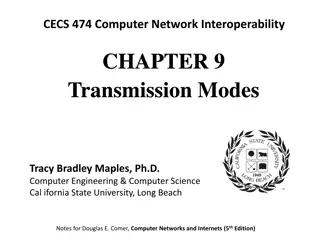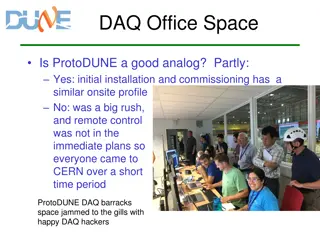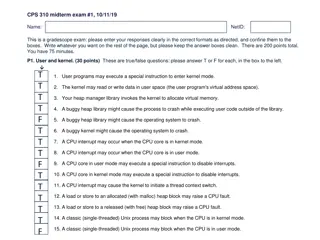Comprehensive Guide to Initial Operational Response (IOR) in Hazardous Substance Incidents
This guide outlines the objectives, principles, and key elements of Initial Operational Response (IOR) to incidents involving hazardous substances or CBRN materials. It covers the stages of response, transition to Specialist Operational Response (SOR), primary objectives of IOR, JESIP principles, an
4 views • 25 slides
Cargo Pricing Strategies Across Transportation Modes (1)
In the realm of logistics and transportation, pricing strategies play a pivotal role in shaping revenue streams and fostering competitiveness. The dynamics of cargo pricing are particularly nuanced, influenced by factors ranging from infrastructure costs to market demand and operational efficiencies
3 views • 6 slides
Mowi Q1 2024 Financial Performance Overview
Mowi's Q1 2024 presentation highlighted operational revenues of EUR 1.33 billion and operational EBIT of EUR 201 million. The quarter posed challenges for Farming Norway, while seeing strong performance in other farming countries. Operational highlights included seasonal effects on costs, record-hig
1 views • 43 slides
Operational Risk Assessment for Major Accident Control: Insights from IChemE Hazards 33 Conference
This content provides valuable insights into the importance of Operational Risk Assessment (ORA) in managing major accident risks in high hazard industries. It covers the necessity of ORA, identifying changes, risk assessment, and key success factors. Real-life examples like the Buncefield Terminal
0 views • 22 slides
Understanding Transport Operations: Modes, Categories, and Efficiency
Explore typical transport operations across various modes, including land, water, and air transportation. Learn about the advantages and disadvantages of different modes, such as road, railway, and air transport. Delve into scheduling long-distance trips and the impact of guidelines on transport eff
1 views • 9 slides
Understanding Addressing Modes in Computer System Architecture
Addressing modes determine how the operand in an instruction is specified, impacting the interpretation and execution. Implied, stack, immediate, direct, indirect, register direct, register indirect, relative, indexed, base register, auto-increment, and auto-decrement are various addressing modes ex
0 views • 4 slides
Understanding Transmission Modes in Computer Networks
Transmission modes in computer networks can be divided into serial and parallel modes. Parallel transmission allows multiple bits to be sent simultaneously over separate media, while serial transmission sends one bit at a time. The choice between serial and parallel transmission depends on factors s
0 views • 13 slides
Enhancing Field Command Operational Activities in Traffic Management
The Federal Road Safety Corps implements a structured field command system to enforce traffic laws in Nigeria. This system includes Zonal, Sector, and Unit Commands with a focus on ensuring highway safety, effective patrols, stakeholder relationships, and timely rescue services. The objective is to
0 views • 20 slides
Addressing Modes and Formats in Instruction Sets
This material discusses addressing modes and formats in instruction sets, covering types of addressing modes, design trade-offs, and the distinction between machine language and assembly language. It explores the need for various addressing techniques to reference locations in memory and presents co
1 views • 58 slides
Understanding Synthetic Aperture Radar (SAR) Modes and Implementations
Explore the world of Synthetic Aperture Radar (SAR) through various modes and implementations, covering topics such as SAR coordinate systems, pulse compression, range-Doppler algorithms, Born approximation, SAR scene simulation, and more. Dive into the distinctions between unfocused SAR and focused
0 views • 18 slides
IEEE 802.11-20/0586r4 MLO Indication of Critical Updates
The document discusses the need for a mechanism in the MLO framework to enable non-AP MLDs to receive updates to operational parameters without monitoring all links. It proposes that each AP of an MLD should provide an indication of updates to another AP's operational parameters. It also outlines ho
0 views • 17 slides
Enrollment Reconciliation Operational Calendar March-July 2022
Pre-Audit and Enrollment Reconciliation operational calendar outlining key dates for March to July 2022. Includes information on file deliveries, submission deadlines, dispute corrections, and miscellaneous files. Calendar subject to operational imperatives and changes. Details not releasable to the
0 views • 9 slides
Understanding Addressing Modes in Assembly Language
This content delves into the intricacies of addressing modes in assembly language, covering topics such as one-dimensional arrays, the DUP operator for defining arrays, and various modes like register, immediate, direct, and register-indirect modes. It explains how operands are specified in differen
2 views • 24 slides
Understanding Waveguides in Electromagnetic Theory
The concept of waveguides in electromagnetic theory involves the transmission of electromagnetic waves through hollow metallic tubes, such as rectangular and circular waveguides made from materials like copper and aluminum. These waveguides support different modes of propagation, including TE, TM, a
5 views • 15 slides
Understanding Addressing Modes in 8051 Microcontroller
Addressing modes in the 8051 microcontroller play a crucial role in specifying how data is accessed and operated by instructions. They include register addressing, direct addressing, register indirect addressing, immediate addressing, and indexed addressing modes. Each mode offers unique ways to han
2 views • 20 slides
Understanding Addressing Modes in 8086
Delve into the world of addressing modes in the 8086 processor to comprehend how different types of operands are accessed and utilized during instruction execution. Explore immediate, direct, register, register-indirect, and other addressing modes with detailed examples.
1 views • 17 slides
Understanding Operational Amplifier (Op-Amp) Comparator Circuits
Operational Amplifiers (Op-Amps) are commonly used in comparator circuits to convert analog inputs to digital outputs. In comparator circuits, the Non-Inverting input being higher or lower than the Inverting input determines whether the output is ON or OFF. Real comparators like the 741 or 081 have
1 views • 14 slides
Understanding Operational Amplifiers (Op-Amps) and Their Applications
Operational Amplifiers (Op-Amps) are devices used to amplify signals using an external power source. They are composed of transistors, resistors, and capacitors. Op-Amps find applications in summing amplifiers, AC and DC signal processing, digital-to-analog converters, active filters, oscillators, r
1 views • 41 slides
Navy MC Career Progression in Operational Medicine
This detailed presentation outlines the career pathways and operational opportunities for Navy Medical Corps specialists, emphasizing the need for a balance between clinical excellence and operational leadership. It discusses the various operational billets available at different career stages, the
0 views • 25 slides
Effective Church Councils Training: Character Traits & Operational Values for Leaders
Explore the significance of character traits and operational values for church council members, setting the course for a healthy, life-giving congregation. Learn about the pivotal roles and responsibilities of deacons and elders, emphasizing competencies, character, calling, and core values essentia
3 views • 19 slides
Coupling and Mutual Transformation of Acoustic and Gravitational Modes in Kinematically Complex Flows
This study explores the coupling and mutual transformation of acoustic and gravitational modes in kinematically complex flows. The research delves into phenomena such as stratified fluid, internal gravity waves, and formalism related to background flow and compressible cases. The presentation plan c
0 views • 20 slides
Conceptual Design and Risk Assessment of Forced Safety Injection for Station Blackout Accident Mitigation
This study focuses on the application of Forced Safety Injection Tanks (FSITs) for mitigating accidents like Station Blackout (SBO) in nuclear plants. The research analyzes the need for FSITs, compares FSITs with other safety systems, and discusses the operational strategies for FSITs to prevent cor
1 views • 17 slides
Managing Higher-order Modes in Normal Conducting RF Technology
The excitation of higher-order transverse modes due to misalignments between the beam and RF structures can lead to beam instability in linear colliders. This instability can be mitigated by selectively damping the transverse modes and/or detuning the dipole mode frequencies. Understanding the diffe
0 views • 34 slides
Understanding Transit Modes: A Comparative Analysis by Watkins, LaMondia, and Brakewood
This study delves into defining transit modes, exploring different families of transit modes, and comparing mode selection in the US. The materials developed by K. Watkins, J. LaMondia, and C. Brakewood provide insights into transit mode characteristics like right-of-way systems, technology types, a
0 views • 43 slides
Implementation of Operational Programmes in the Czech Republic: Mid-Term Experience
Sharing insights on the implementation of Operational Programmes in the Czech Republic from 2014-2020, focusing on European Funds, individual operational programmes, and comparisons between programming periods. Emphasis on supporting innovation, R&D, the knowledge economy, and cooperation between se
0 views • 17 slides
Understanding Rectangular Waveguides and Cutoff Frequency
Investigate waveguides supporting non-TEM modes like TE and TM, where cutoff frequency is crucial. Rectangular waveguides with TE and TM modes are explored, detailing mode orders and field configurations. The cutoff frequency formula and standard waveguide designations are also discussed, along with
0 views • 7 slides
Understanding Modes in Data Analysis
Explore the concept of modes in data analysis through examples like ice-cream sales and mathematical connections to fashion. Learn about unimodal, bimodal, and multimodal datasets and how to identify modes effectively. Discover the significance of modes in making decisions and solving real-world pro
0 views • 9 slides
JEREMIE Initiative in Bulgaria Operational Programme Competitiveness 2007-2013
The JEREMIE Initiative in Bulgaria's Operational Programme Competitiveness 2007-2013, driven by the Ministry of Economy and Energy, focused on boosting the Bulgarian economy's competitiveness. It involved various steps and financial engineering instruments to support SMEs. The initiative's timeline
0 views • 26 slides
Cooperative Development of Operational Safety & Continuing Airworthiness Programme - COSCAP-NA Legal Framework Discussion
The COSCAP-NA Phase IV aims to enhance oversight activities for Member States/SARs regarding operational safety and airworthiness. It clarifies different levels of services a COSCAP can offer, with Level 2 involving formal agreements for operational assistance like audits and inspections.
1 views • 21 slides
Operational Ocean Modeling and Forecasting Systems
This content provides an overview of various operational ocean modeling and forecasting systems, including data assimilation processes, glider data, surface and subsurface data sources, forecasting models for hurricanes, and NOAA's hurricane forecasting models. It covers a range of technologies and
0 views • 16 slides
Understanding Failure Modes and Effects Analysis (FMEA) Training
Failure Modes and Effects Analysis (FMEA) is a methodology that helps in process improvement by identifying and eliminating concerns early in the development of a process or design. It aims to improve customer satisfaction, manage risks, and prevent defects. Training objectives include understanding
0 views • 25 slides
Sugar, Ethanol & Energy Business Operational Performance Analysis
This report analyzes the operational performance of a sugar, ethanol, and energy business including sugarcane crushing, production mix, sales volumes, financial performance, and agricultural operations. Key highlights include significant increases in sugarcane crushing, production volumes, and sales
0 views • 14 slides
Organizing DAQ and Operational Spaces for ProtoDUNE Project
In the context of the ProtoDUNE project, the organization of DAQ and operational spaces is crucial for efficient functioning. The initial installation at CERN faced challenges, prompting the need for remote control capabilities. The setup at SURF requires a thoughtful layout to accommodate key subsy
0 views • 8 slides
Locally-Unique Address Assignment Protocols in IEEE 802 Networks
This content discusses the Local MAC Address Protocol for locally-unique assignment of 48-bit and 64-bit addresses in IEEE 802 networks. It specifies protocols, procedures, and management objects for address assignment in a structured manner. The document also covers peer-to-peer claiming, server mo
0 views • 11 slides
Understanding ESD Force, Noise, and Range in Various Modes
This content discusses ESD force, noise, and range in different modes of operation, presenting assumptions, possible operation modes, and details on maximum range mode and noise characteristics. It explores concepts like control voltage offset, force noise calculations, and practical applications fo
0 views • 9 slides
Understanding Availability and Maintainability in Engineering
Availability and maintainability are crucial aspects in engineering, defining the system's operable state and its ability to fulfill missions. Availability is the probability of the system being operational when called for, contingent on factors such as failure occurrence, maintenance frequency, and
0 views • 74 slides
Understanding User and Kernel Modes in Operating Systems
The content provided discusses various aspects of user and kernel modes in operating systems through a set of true/false questions related to user programs, CPU interrupts, heap management, and process behavior in different modes. It touches on the role of the kernel in managing virtual memory, hand
0 views • 10 slides
The Time Cost Distance Model
The Time Cost Distance Model in Transit Corridors aims to illustrate the cost and time aspects of door-to-door movement along available routes and modes within a transit transport corridor while highlighting delays at borders or inspection points. The model proposes a methodology based on cost and t
0 views • 14 slides
C-WAM: U.S. Army Operational Wargaming Analysis Model
The Center for Army Analysis Wargame Analysis Model (C-WAM) is a manual, computer-aided, time-step, force-on-force simulation methodology used by the U.S. Army to analyze campaign-level operational courses of action. Developed over ten years, C-WAM provides a detailed understanding of theater backdr
0 views • 20 slides
Understanding Semiotics and Multimodality in Communication
Exploring the realm of semiotics and multimodality, this study delves into the use of multiple semiotic modes in communication. It discusses the significance of combining different modes like verbal, visual, and aural symbols to convey messages effectively. The concept of multimodal texts and their
0 views • 19 slides







































